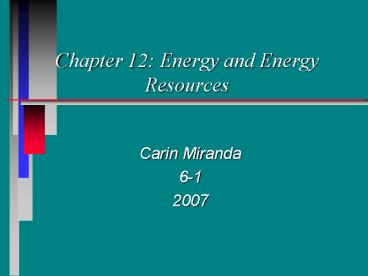Chapter 12: Energy and Energy Resources PowerPoint PPT Presentation
1 / 24
Title: Chapter 12: Energy and Energy Resources
1
Chapter 12 Energy and Energy Resources
- Carin Miranda
- 6-1
- 2007
2
What is Energy?
- Energy is the ability to do work.
- Work and energy are both expressed in joules (J).
3
Kinetic Energy
- Kinetic energy is the energy of motion.
- All moving objects have kinetic energy.
- Kinetic energy mass times speed squared divided
by 2. - The faster something is moving, the more kinetic
energy it has. - The more massive the object the more kinetic
energy it has.
4
Potential Energy
- Potential energy is energy based on shape or
position. - Gravitational potential energy is based on height
and weight. - The higher an object the more potential energy.
- The more massive an object the greater the
potential energy.
5
Mechanical Energy
- Mechanical energy is the total energy of motion
and position. - In other words it is kinetic plus potential.
- As potential goes up kinetic goes down and vice
versa.
6
Forms of energy
- Thermal (Heat)
- Chemical
- Electrical
- Sound
- Light
- Nuclear
7
Thermal
- Higher temperature objects have more thermal
energy and more kinetic energy. - The particles in steam move faster than the
particles in ice. - The more particles the more thermal energy.
- A bathtub full of 75 degree water would have more
thermal energy than a cup full of 75 degree water.
8
Chemical Energy
- When particles are broken down and cannot return
to their original form they have chemical energy. - Examples Food, Charcoal, gasoline, firewood.
9
Electrical Energy
- Moving electrons.
- Any electrical appliances or anything using
electricity. - Huge magnets are rotated to produce the
electricity you use at home.
10
Sound Energy
- Caused by an objects vibrations.
- It is a form of potential and kinetic energy.
11
Light Energy
- Vibrations of electrically charged particles.
- Not all light energy is seen.
- Microwaves use light energy.
12
Nuclear Energy
- Two or more nuclei join together (nuclear
fusion). Example Sun - Nucleus of an atom splits apart (nuclear
fission). Example Uranium atoms split apart to
produce electricity.
13
Energy Conversions
- Any change from one form of energy to another.
14
Kinetic to Potential
- Remember we said as potential energy goes up
kinetic goes down and vice versa. - Examples Person on a trampoline, pendulum, and
wind up toys.
15
Chemical Energy Conversions
- Chemical energy in food is converted into kinetic
energy when you move. - It is stored as potential energy when you arent
moving. - Where did that chemical energy come from in food?
- The sun gives plants light energy and they
convert it into chemical energy. - Batteries are another example of chemical energy.
16
Electrical Energy Conversions
- Lots of examples
- Alarm clock electrical to light and sound.
- Battery chemical to electrical
- Light bulb electrical to light, thermal, and
sometimes sound. - Blender electrical to kinetic and sound
17
Energy and Machines
- Machines make work easier by changing the size
and/or direction of the force required to do the
work.
18
Why Conversions are Important
- Make energy useful.
- Make conversions more efficient.
19
Conservation of Energy
- Friction is a force that opposes motion between
two surfaces that are touching. - When energy is used to overcome friction some
energy is converted into thermal energy. - On a roller coaster potential energy is greatest
at the top of the biggest hill and kinetic energy
is greatest at the bottom of the biggest hill.
20
Law of Conservation of Energy
- Energy can be neither created nor destroyed.
- It can change from one form to another.
- Every time an energy conversion takes place some
energy is always converted into thermal energy.
21
Energy Resources
- A natural resource that can be converted by
humans into another form of energy to do useful
work. - Can be nonrenewable or renewable.
22
Nonrenewable
- Cannot be replaced easily.
- Fossil Fuels Formed from the buried remains of
plants and animals that lived millions of years
ago. - Coal, petroleum, and natural gas.
- Electrical energy from fossil fuels.
- Nuclear Energy (Uranium pellets).
23
Renewable
- Can be replaced over a relatively short period of
time. - Solar Energy (SUN).
- Energy from water (Hydroelectric).
- Wind Energy.
- Geothermal (Hot water in the ground).
- Biomass (garbage).
24
Advantages and Disadvantages of Nuclear Energy
- Advantages very concentrated form of energy and
nuclear power plants dont produce smog (CO2). - Disadvantages Produces radioactive waste and it
is nonrenewable.

